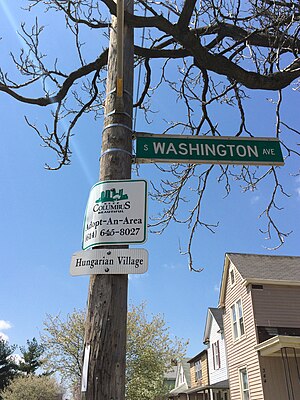Hungarian Village
| Hungarian Village | |
|---|---|
| Neighborhoods of Columbus, Ohio | |

Gateway sign for Hungarian Village
|
|
| Coordinates: 39°55′41″N 82°59′25″W / 39.92811°N 82.99014°WCoordinates: 39°55′41″N 82°59′25″W / 39.92811°N 82.99014°W | |
| ZIP Code | 43207 |
| Area code(s) | 614 |
Traveling South on High Street through downtown Columbus and passing over Interstates 70 and 71, one will find themselves among several historic neighborhoods, including the well-known German Village. Nestled between the Reeb-Hosack neighborhood to its south and Merion Village to its north, Hungarian Village quietly sits within the boundaries of Parsons Avenue, South High Street, Woodrow Avenue and Hinman Avenue.
Hungarian village is contained within the original boundaries of the Merion estate, established by Nathaniel Merion in 1809. This area is part of the Refugee Tract, where Congress compensated Refugee Soldiers, or Loyalists, for their service in the American Revolutionary War. Throughout history this area was settled and populated–first by Early British and Nova Scotian settlers and later by many German, Italian, and Irish immigrants–during the Building Boom of the early 1900s when the area became known as ‘Steelton’. In 1913 the Hungarian Reformed Church was established and later rebuilt in 1923. Located at the intersection of East Woodrow Avenue and South Washington Avenue the church lies on the far south border of the community. One corner stone on the face of the Hungarian Reformed church is inscribed with “United Magyar Protestant Church June 26, 1921”. This simple inscription links the church and its early Hungarian immigrant congregation to the Magyars of Hungary. In 1922 there were an estimated 1,200 Magyars living in Columbus. It is of no surprise that many Hungarian refugees came to the area during the failed 1956 Hungarian Revolution, while many others would settle in Cleveland, New Jersey, and New York. In 1973 it was Reverend Zoltan Szabo that proposed the idea of defining the community as Hungarian Village, looking at the revitalization in nearby German Village as a model for a successful community. Twenty-five years after the Hungarian Revolution a plaque was erected, recognizing the Hungarians who died for human rights and freedom. This memorial stands outside of the Hungarian Reformed Church which still houses the Hungarian Village Society today. In 1991, Hungarian President Árpád Göncz visited the village on a seven-day U.S. trip, stopping at the Hungarian Reformed Church.
...
Wikipedia
